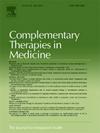呼吸运动项目对非特异性颈部疼痛患者疼痛、残疾和呼吸模式的影响:一项随机对照试验。
IF 3.5
3区 医学
Q1 INTEGRATIVE & COMPLEMENTARY MEDICINE
引用次数: 0
摘要
背景:上胸部呼吸模式可增加副肌激活,降低颈椎稳定性,导致颈部疼痛。目的:研究呼吸锻炼方案对非特异性颈部疼痛患者疼痛、颈椎活动度、残疾、呼吸模式和肌肉耐力的影响。设计:随机对照试验方法:纳入32例非特异性颈部疼痛和上胸呼吸方式的患者。该研究于2021年7月19日至9月3日在物理治疗中心进行。参与者被随机分配到呼吸运动(BE)组或颈部运动(NE)组。两组均行热电治疗、软组织松弛、胸椎活动。BE组进行呼吸练习,而NE组进行一般的颈部练习。测量干预前后疼痛强度、颈部残疾指数、颈椎活动度、呼吸方式、颈深屈肌耐力。配对t检验和独立t检验比较组内和组间检验前后的差异。结果:两组疼痛强度和NDI均有显著改善(疼痛:BE vs NE平均差异0.34,95% CI -0.25 ~ 0.93, p= 0.239; NDI: 0.86, 95% CI -0.62 ~ 2.34, p= 0.249)。呼吸模式仅在BE组得到改善(平均差异2.73,95% CI 1.78至3.68)。结论:呼吸练习改善了非特异性颈部疼痛患者的呼吸模式,但对疼痛和残疾的影响尚无定论。本文章由计算机程序翻译,如有差异,请以英文原文为准。
The impact of a breathing exercise program on pain, disability, and breathing patterns in patients with non-specific neck pain: A randomized controlled trial
Background
Upper chest breathing patterns can increase accessory muscle activation and reduce cervical stability, contributing to neck pain
Objective
To examine the effects of a respiratory exercise program on pain, cervical range of motion, disability, breathing patterns, and muscular endurance in patients with non-specific neck pain.
Design
randomized controlled trial
Methods
Thirty-two patients with non-specific neck pain and upper chest breathing patterns were included. The study was conducted from July 19, 2021, to September 3, at a physical therapy center. Participants were randomly assigned to a breathing exercise (BE) or neck exercise (NE) group. Thermoelectric therapy, soft tissue relaxation, and thoracic spine mobilization were performed in both groups. The BE group performed breathing exercises, whereas the NE group performed general neck exercises. Pain intensity, neck disability index, cervical range of motion, breathing pattern, and deep cervical flexor endurance were measured before and after the intervention. Paired t-test and independent t-test compared pre- and post-test differences within and between groups.
Results
Both groups showed significant improvements in pain intensity and NDI (pain: BE vs NE mean difference 0.34, 95 % CI –0.25–0.93, p = .239; NDI: 0.86, 95 % CI –0.62–2.34, p = .249). Breathing pattern improved only in the BE group (mean difference 2.73, 95 % CI 1.78–3.68, p < .001). Endurance of deep cervical flexors increased in both groups, greater in NE (mean difference –15.98, 95 % CI –25.26 to –6.70, p = .010).
Conclusion
Breathing exercises improved breathing patterns in patients with non-specific neck pain, but effects on pain and disability were inconclusive.
求助全文
通过发布文献求助,成功后即可免费获取论文全文。
去求助
来源期刊

Complementary therapies in medicine
医学-全科医学与补充医学
CiteScore
8.60
自引率
2.80%
发文量
101
审稿时长
112 days
期刊介绍:
Complementary Therapies in Medicine is an international, peer-reviewed journal that has considerable appeal to anyone who seeks objective and critical information on complementary therapies or who wishes to deepen their understanding of these approaches. It will be of particular interest to healthcare practitioners including family practitioners, complementary therapists, nurses, and physiotherapists; to academics including social scientists and CAM researchers; to healthcare managers; and to patients. Complementary Therapies in Medicine aims to publish valid, relevant and rigorous research and serious discussion articles with the main purpose of improving healthcare.
 求助内容:
求助内容: 应助结果提醒方式:
应助结果提醒方式:


